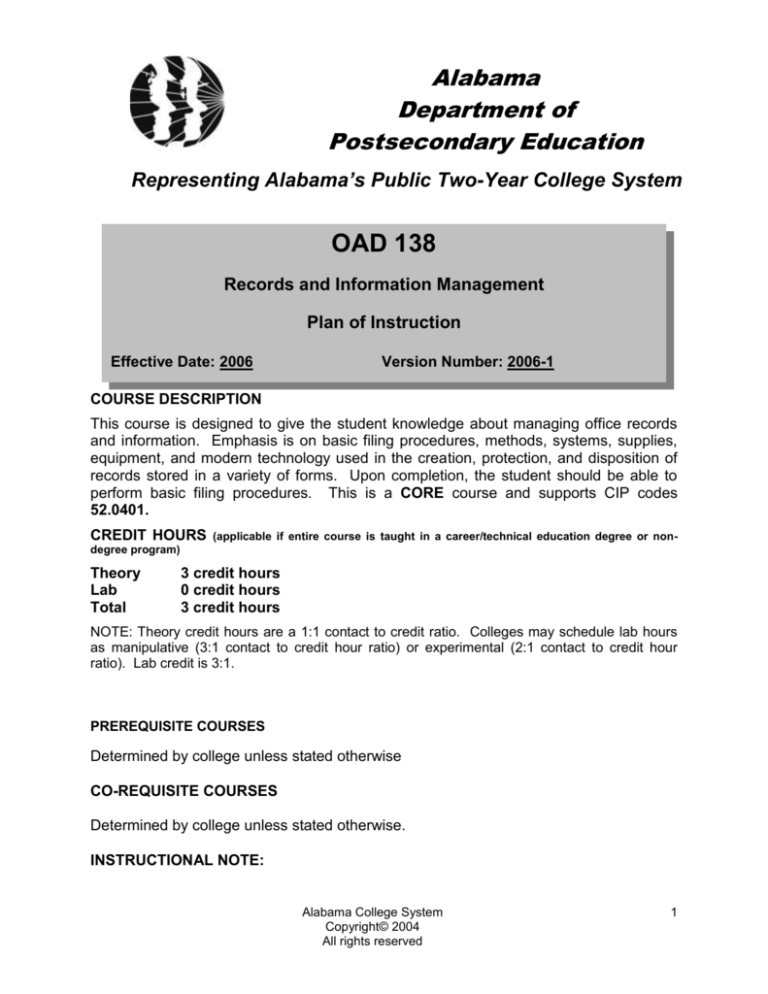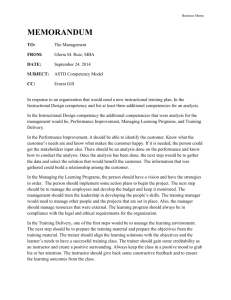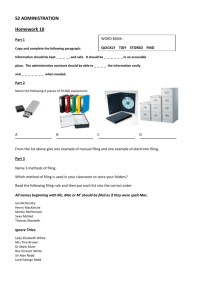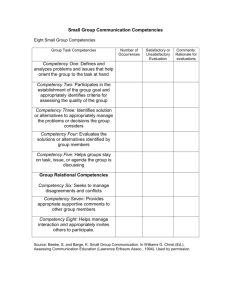
Alabama
Department of
Postsecondary Education
Representing Alabama’s Public Two-Year College System
OAD 138
Records and Information Management
Plan of Instruction
Effective Date: 2006
Version Number: 2006-1
COURSE DESCRIPTION
This course is designed to give the student knowledge about managing office records
and information. Emphasis is on basic filing procedures, methods, systems, supplies,
equipment, and modern technology used in the creation, protection, and disposition of
records stored in a variety of forms. Upon completion, the student should be able to
perform basic filing procedures. This is a CORE course and supports CIP codes
52.0401.
CREDIT HOURS
(applicable if entire course is taught in a career/technical education degree or non-
degree program)
Theory
Lab
Total
3 credit hours
0 credit hours
3 credit hours
NOTE: Theory credit hours are a 1:1 contact to credit ratio. Colleges may schedule lab hours
as manipulative (3:1 contact to credit hour ratio) or experimental (2:1 contact to credit hour
ratio). Lab credit is 3:1.
PREREQUISITE COURSES
Determined by college unless stated otherwise
CO-REQUISITE COURSES
Determined by college unless stated otherwise.
INSTRUCTIONAL NOTE:
Alabama College System
Copyright© 2004
All rights reserved
1
Records and Information Management
OAD 138
This course is designed as a practical, hands-on approach to all types of filing systems.
Emphasis is placed on the key alphabetic filing systems, including manual, subject,
geographic, numeric, micrographic, and electronic.
INDUSTRY/PROFESSIONAL COMPETENCIES:
Explain the attributes within accurate records and information management
systems.
Use selected logistic and organizational skills to manage supplies and storage
equipment.
Classify selected documents with 100% accuracy.
GENERAL INSTRUCTIONAL OBJECTIVES
The cognitive objective for this course is for each student to comprehend foundational
knowledge of records and information management, of classifying records, and of the
supplies and storage equipment used in a records management system.
The performance objective of this course is for each student to apply and demonstrate
foundational knowledge of using records management systems in a simulated realworld environment.
INDUSTRY/PROFESSIONAL COMPETENCIES/STUDENT PERFORMANCE
MODULE A – RECORDS MANAGEMENT SYSTEMS
INDUSTRY/PROFESSIONAL
COMPETENCIES
A1.0 Explain the attributes
STUDENT PERFORMANCE OBJECTIVES
A1.1 This competency is measured cognitively.
within accurate
records and
information
management systems.
(B)
Alabama College System
Copyright© 2004
All rights reserved
2
Records and Information Management
OAD 138
ENABLING OBJECTIVES/KEY INDICATORS
KSA
Indicator
A1.1.1 Identify and differentiate between historical records, operational
records, Legal records, fiscal records, vital records, important
records, useful records, and nonessential records.
A1.1.2 Describe how records are classified.
A1.1.3 Identify Reference/Transaction documents and how they are used.
A1.1.4 Differentiate between internal and external documents.
A1.1.5 Describe the life cycle of a record.
A1.1.6 Explain the features of manual, micrographic, and electronic
.records storage systems.
A1.1.7 Describe centralized and decentralized filing systems.
A1.1.8 Explain computer-based records systems.
A1.1.9 Identify records according to the Association of Records Managers
and Administrators (ARMA) Alphabetic Filing Rules.
B
B
B
B
B
B
A
B
C
MODULE B – SUPPLIES AND STORAGE
INDUSTRY/PROFESSIONAL
COMPETENCIES
B1.0 Use selected logistic
and organizational skills
to manage supplies and
storage equipment. (2c)
STUDENT PERFORMANCE OBJECTIVES
B1.1 Given selected office and supply requirements,
organize and store all specified items.
ENABLING OBJECTIVES/KEY INDICATORS
KSA
Indicator
B1.1.1 Identify the various supplies and storage equipment used in filing.
B1.1.2 Explain the purpose and proper use of color-coded filing systems.
A
B
MODULE C – CLASSIFYING RECORDS
INDUSTRY/PROFESSIONAL
COMPETENCIES
C1.0 Classify selected
documents with 100%
accuracy. (3c)
STUDENT PERFORMANCE OBJECTIVES
C1.1 Demonstrate proper application of ARMA
alphabetic filing rules as applicable for each filing
arrangement (alphabetic, subject, geographic,
numeric)
KSA
Indicator
ENABLING OBJECTIVES
C1.1.1 Apply academic filing rules as they apply to personal or individual
names
Alabama College System
Copyright© 2004
All rights reserved
b
3
Records and Information Management
OAD 138
COURSE CONTENT OUTLINE
MODULE A – Records Management Systems
The different values of records
- Historical Records
- Operational Records
- Legal Records
- Fiscal Records
- Vital Records
- Important Records
- Useful Records
- Nonessential Records
How records are classified
- Reference/Transaction Documents
- Internal Documents
- External Documents
The life cycle of a record
- Creation
- Distribution
- Application or use
- Maintenance
- Disposition
The features of manual, micrographic, and electronic records storage systems
- Centralized Filing Systems
- Decentralized Filing Systems
- Micrographic Records Systems
- Computer-Based Records Systems
MODULE B – SUPPLIES AND STORAGE
Supplies and Storage Equipment
Color-coded Filing System
MODULE C – CLASSIFYING RECORDS
Association of Records Managers and Administrators (ARMA) Alphabetic
Filing Rules
- Alphabetic filing rules as they apply to personal or individual names
- Alphabetic filing rules as they apply to business names
Subject Filing Arrangement
Geographic Filing Arrangement
Numeric Filing Arrangement
Alabama College System
Copyright© 2004
All rights reserved
4
Records and Information Management
OAD 138
LEARNING OBJECTIVES TABLE OF SPECIFICATIONS
The table of specifications below identifies the percentage of objectives at a cognitive
level for each module. Instructors should develop sufficient numbers of test items at
the appropriate level of evaluation.
ENABLING OBJECTIVES TABLE OF SPECIFICATIONS
Cognitive Domain
Module A
Module B
Module C
Facts/
Nomenclature
A/a
11%
50%
Principles/
Procedures
B/b
77%
50%
100%
Alabama College System
Copyright© 2004
All rights reserved
Analysis/
Operating
Principles
C/c
11%
Evaluation/
Complete
Theory
D/d
5
Records and Information Management
OAD 138
Knowledge, Skills, and Abilities (KSA) Indicators
Performance
Ability
Value
4
Key Word(s)
Highly
Proficient
3
Proficient
2
Knowledge
Knowledge of Skills
1
d
c
Partially
Proficient
Limited
Proficiency
Complete
Theory
Operating
Principles
b
Procedures
a
Nomenclature
D
Evaluation
C
Analysis
B
Principles
A
Facts
Definition
Can do the complete competency quickly and accurately. Can tell or
show others how to do the competency.
Can do all parts of the competency. Needs only a spot check of
completed work
Can do most parts of the competency. Needs help only on hardest
parts.
Can do simple parts of the competency. Needs to be told or shown
how to do most of the competency.
Can predict, isolate, and resolve problems about the competency
Can identify why and when the competency must be done and why
each step is needed.
Can determine step-by-step procedures for doing the competency.
Can name parts, tools, and simple facts about the competency.
Can evaluate conditions and make proper decisions about the
subject.
Can analyze facts and principles and draw conclusions about the
subject.
Can identify relationship of basic facts and state general principles
about the subject.
Can identify basic facts and terms about the subject
Alpha Scale Values - Any item with an upper case letter (A, B, C, D) by itself is taught as general information on a
topic. This information may be related to the competency or encompass multiple competencies. Examples might
include mathematical computations or knowledge of principles such as Ohm’s Law.
A lower case letter indicates a level of ”Knowledge of Skills." Individuals are taught information pertaining to
performing a competency . These may be indicated alone or in conjunction with a numerical scale value. A lower case
letter by itself indicates the individual is not required to perform the task-just know about the task. (Example: Can state
or explain procedures for doing a task).
Numerical Scale Values - The numbers reflect the levels the individual will be able to perform a competency. Number
values are always accompanied by lower case letters (i.e. 1a, 2b, 3c...etc.) in order to specify the level of knowledge of
skills associated with the competency.
Example: An individual with a competency with a scale indicator of 3b has received training of knowledge of skills
whereby he or she can determine the correct procedures and perform with limited supervision; only requiring evaluation
of the finished product or procedure.
NOTE: Codes indicate terminal values.
Alabama College System
Copyright© 2004
All rights reserved
6
Records and Information Management
OAD 138
RECOMMENDED INSTRUCTIONAL METHODOLOGIES: The table below links the teaching
methods and activities most effective for facilitating student achievement of learning outcomes
published in this plan of instruction.
Cognitive Level
Goal for Students
Teaching Methods
Teaching Activities
(Thinking)
Knowledge
Descriptive Verbs:
Defines, Lists, States,
Describes, Identifies
Comprehension
Descriptive Verbs:
Describe, Explains,
Summarizes
Knows common terms,
specific facts, methods,
procedures, basic
concepts, principles
Understands facts and
principles
Interprets verbal material
Interprets charts and
graphs
Lecture
Computer-based
Instruction
Video
Demonstration
Informal Lecture
Discussion
Demonstration
Participation
Interactive Computer
Based Instruction
Translates verbal material
to mathematical formulas
Estimates future
consequences
Mnemonics
Examples or Illustrations
Repetition
Summaries
Reviews
1. Teach to the Knowledge Level
2. Explains and demonstrates
concept, principle or procedure
learned
3. Put students in new
situation, and instructor and
students co-solve employing
the indicated concept, principle,
or procedure.
4. Put students in a new situation,
and the students solve the new
situation using the concept,
principle, or procedure while
instructor supervises.
Justifies methods and
procedures
5. Remediate/Reteach as required
Application
Descriptive Verbs:
Uses, Solves, Operates,
Produces,
Demonstrates, Constructs
Applies concepts and
principles to new situations
Applies laws and theories
to practical situations
Solves mathematical
problems
Demonstration
Individual Research
Lab Exercises
Case Studies
Experiments
Clinicals
Demonstrates correct
usage of a method or
procedure
Mechanism
Descriptive Verbs:
Assembles, calibrates, inserts,
removes, constructs,
measures, fixes, dismantles,
sketches
Goal for Students
Learned responses have
become habitual and can
be performed with some
confidence and proficiency
as designated by the KSAs
2. Teach to the Comprehension
Level
3. Student must identify the
concept, principle, or procedure
and use it to solve new
scenario(s)
Constructs charts, graphs,
or simple mechanisms
Psychomotor Level
(Doing)
1. Teach to the Knowledge Level
4. Remediate/Reteach as required
Teaching Methods
Lab Exercises
Case Studies
Experiments
Alabama College System
Copyright© 2004
All rights reserved
Teaching Activities
1. Demonstration
2. Observation
3. Evaluation
4. Feedback
5. Remediate/Reteach as required
7
Records and Information Management
OAD 138
Glossary of Terms
Plan of Instruction (POI)
A teaching-learning plan which includes student centered instructional objectives,
outlined content, instructional and evaluation strategies, and other relevant
information needed to guide the development and/or revision of learning
experiences such that students achieve stated educational and performance
outcomes.
Industry/Professional
Competencies
A major task that individuals perform in a given industry or profession . From
these major tasks, performance objectives can be developed. Meeting
performance objectives indicates a student has attained the associated
industry/professional competencies. Taken together, these support the Course
Instructional Objectives.
Course Instructional
Objectives
The overall goal of the course of instruction stated in broad terms. This is
supported by the attainment/completion of the competencies and associated
competency tasks and sub-tasks.
Task
A skill that individuals perform that enables them to accomplish and satisfactorily
complete/attain as given competency.
Student Performance
Objectives
The skills each student is required to demonstrate during or at the conclusion of
each module or course. These skills are the direct result of the
attainment/completion of the professional competencies.
Enabling Objectives/Key
Indicators
The required knowledge and/or skill each student must acquire in order to have the
best chance of achieving the stated Student Performance Objective.
Knowledge, Skills, and
Abilities (KSA) Indicator
A table that provides an alpha/numeric indicator of knowledge, knowledge of skills,
and performance ability(s) students must demonstrate at the conclusion of
specified instruction. Each competency designates the terminal level of KSA
students must achieve. Enabling objectives/Key Indicators have a separate KSA
designating the level of knowledge students must have in order to perform the
associated competency(s).
Modules
A grouping of interrelated knowledge and skills representing a sub-task of a
course. Modules may be taught independently of other course content.
Prerequisite Courses
Courses students are required to successfully complete before being allowed
entrance into other courses
Instructional Note
Knowledge and skills relevant to the course that students will be demonstrating
during the course. For example: computer, technical writing, mathematics, and
speaking skills.
Alabama College System
Copyright© 2004
All rights reserved
8
Records and Information Management
Course Prefix/numbers
Co-requisite Course
Modules
Course Content Outline
Contact/Credit hours
Prerequisite Knowledge
Recommended Methods of
Evaluation
Recommended Instructional
Methodologies
Course Prefix/numbers
Co-requisite Course
Modules
Course Content Outline
Contact/Credit hours
Prerequisite Knowledge
Recommended Methods of
Evaluation
Recommended Instructional
Methodologies
OAD 138
GLOSSARY OF TERMS (Cont)
Used to identify courses taught in multiple disciplines.
Course required in conjunction to the specified course often in the form of a lab
A grouping of interrelated knowledge and skills representing a sub-element of a
course.
A listing of topics for instruction in a particular course
Specifies the recommended contact to credit hours for each course. Mandates the
total credit hours awarded for each course.
Intellectual capabilities required for handling the academic rigors of the discipline.
Suggests test item options for measuring student achievement of enabling
objectives. Suggests the number of test items required to adequately measure
student achievement of enabling objectives. Mandates the evaluation of criterion
objectives.
Suggests the most effective instructional methods for achieving stated learning
levels
Used to identify courses taught in multiple disciplines.
Course required in conjunction to the specified course often in the form of a lab
A grouping of interrelated knowledge and skills representing a sub-element of a
course.
A listing of topics for instruction in a particular course
Specifies the recommended contact to credit hours for each course. Mandates the
total credit hours awarded for each course.
Intellectual capabilities required for handling the academic rigors of the discipline.
Suggests test item options for measuring student achievement of enabling
objectives. Suggests the number of test items required to adequately measure
student achievement of enabling objectives. Mandates the evaluation of criterion
objectives.
Suggests the most effective instructional methods for achieving stated learning
levels
Alabama College System
Copyright© 2004
All rights reserved
9
Records and Information Management
OAD 138
Northeast Alabama Community College
Evaluation of Learning Outcomes for Career/Technical Courses
Student Learning Outcomes Form 1
Faculty regularly review the extent to which the course and program learning outcomes identified in a
course syllabus are being attained by students who complete the course. Each syllabus identifies the
assessment method that will be used to demonstrate student mastery of the desired learning outcomes
for that course. Before teaching a course, faculty should review the syllabus to understand how the
learning outcomes will be evaluated. Once the course is complete, this form is used by the instructor to
report how well students demonstrated mastery of those course learning (and by extension, program
learning) outcomes.
Course Prefix & No.: OAD 138
Instructor:
Semester:
Type of Delivery – Mark One*:
Course Title: Records and Information Management
Date:
Section Number(s):
Dual Enrollment
Online
Traditional
*Double click on the appropriate box. When the form field menu appears, select “checked” under Default value.
Note: To insert or delete rows on the table, click on Table on the tool bar.
Learning Outcome
Evaluation Method
Evaluation Results
(Industry or Professional
Competency)
Explain how each learning outcome for this course is
assessed.
Of the students who earned a grade
of C or better for the course, what
percentage demonstrated attainment
of the stated outcomes?
Explain the attributes
within accurate
records and
information
management systems.
Use selected logistic
and organizational
skills to manage
supplies and storage
equipment.
On a given exam, students will explain the
attributes within the accurate records and
information management systems with an
accuracy of at least 70%.
On a given assignment, students should be
able to demonstrate with at least 80%
accuracy the ability to organize and store all
specified items using selected office and
supply requirements
Students will classify documents through
Classify selected
proper application of ARMA alphabetic filing
documents with 100%
rules as applicable for each filing
accuracy.
arrangement (alphabetic, subject,
geographic, and numeric) with at least 80%
accuracy.
Use of Evaluation Results
Explain how evaluation results will be used to improve the course.
*Reviewed:
Division Director or Program Supervisor
Date
*To be completed by Division Director or Program Supervisor Only
Alabama College System
Copyright© 2004
All rights reserved
10







